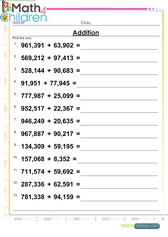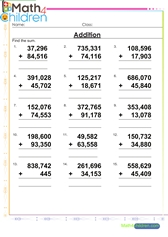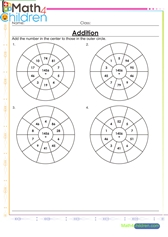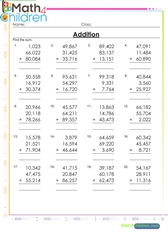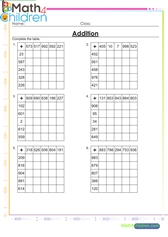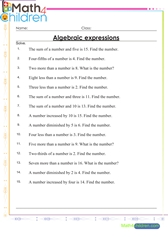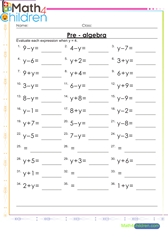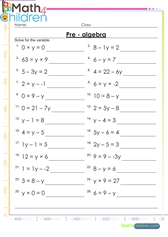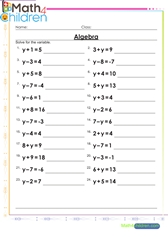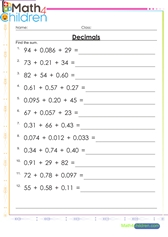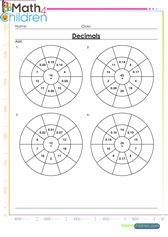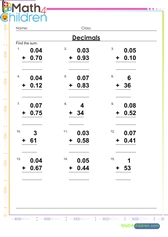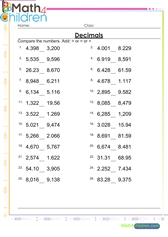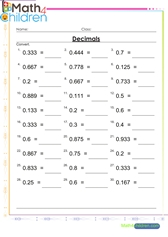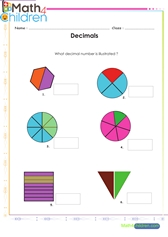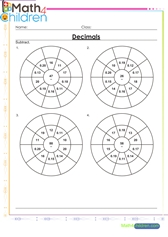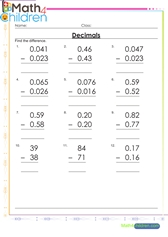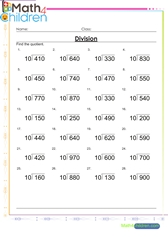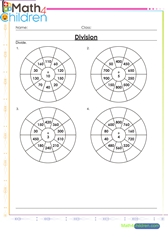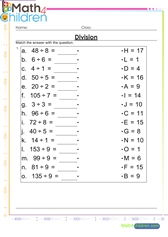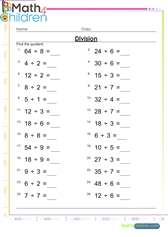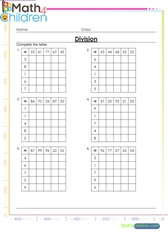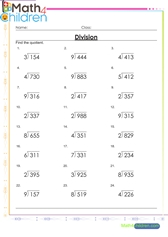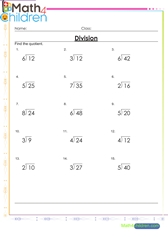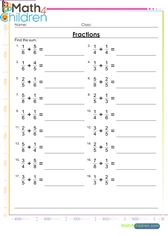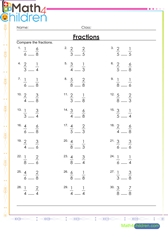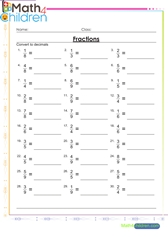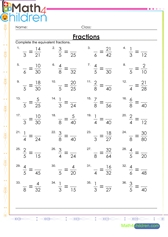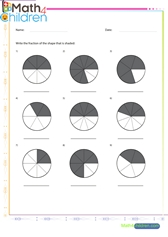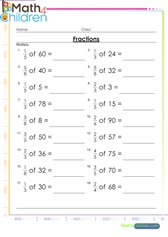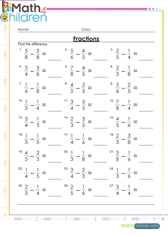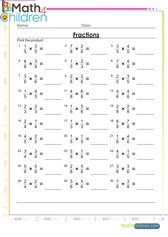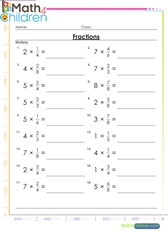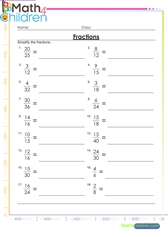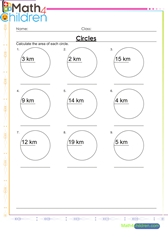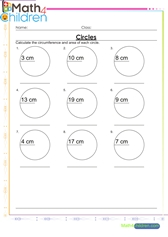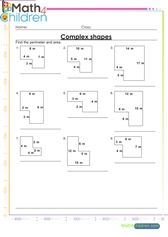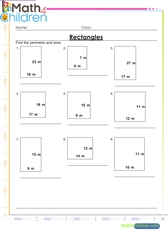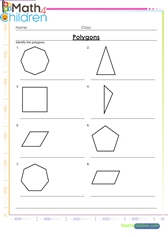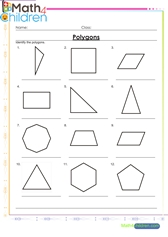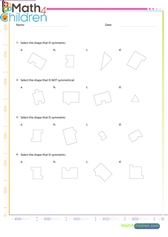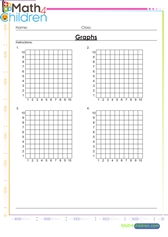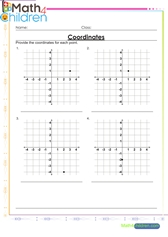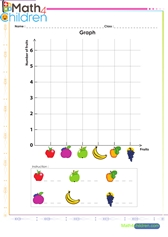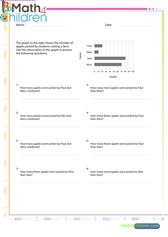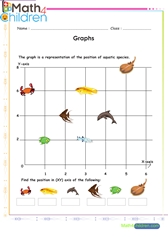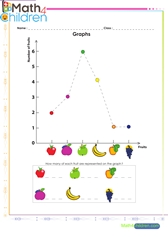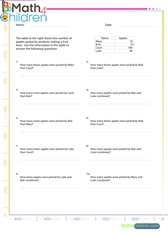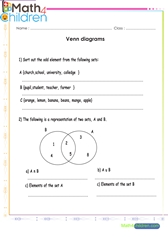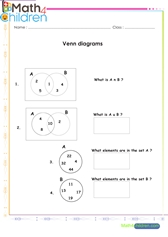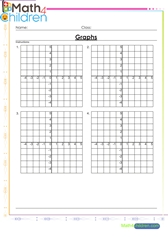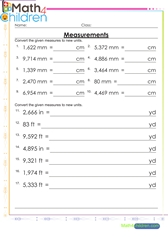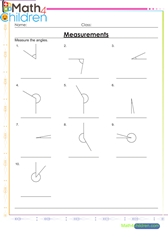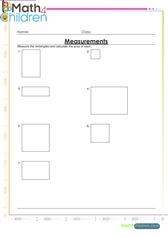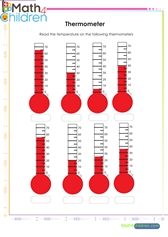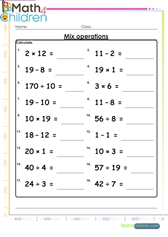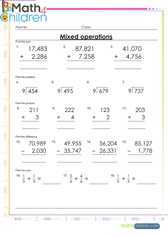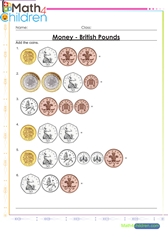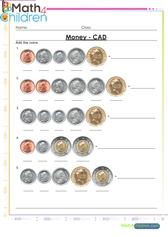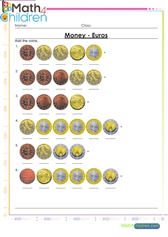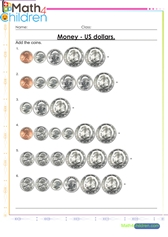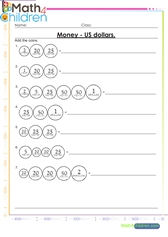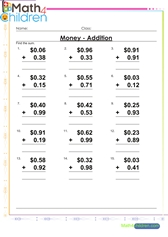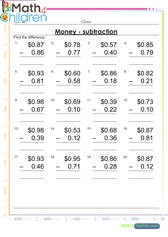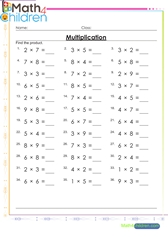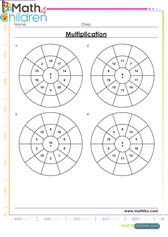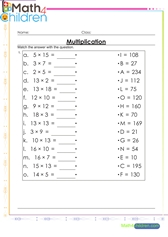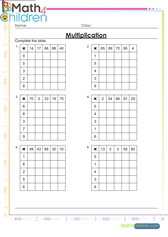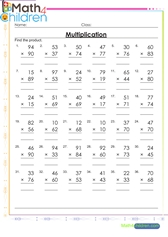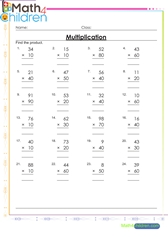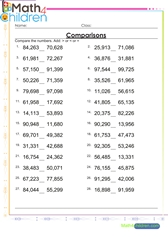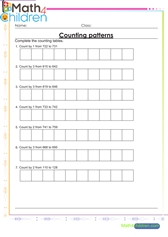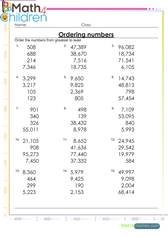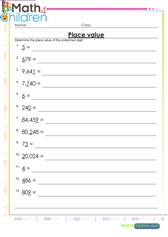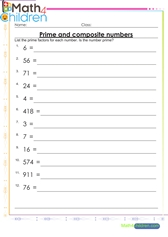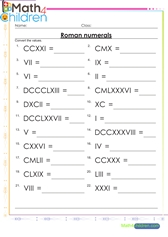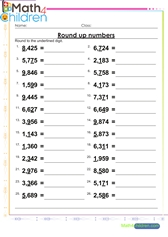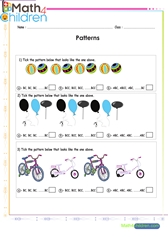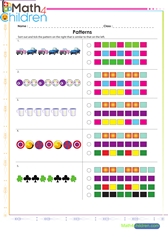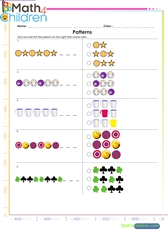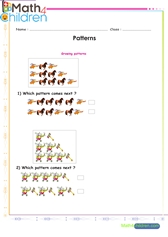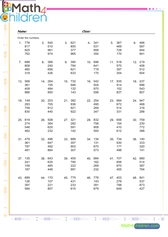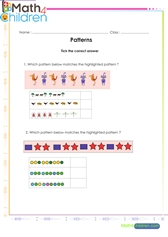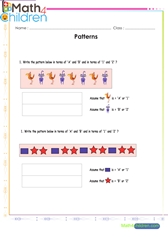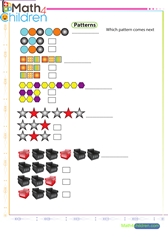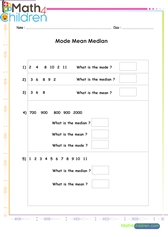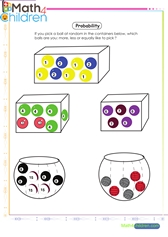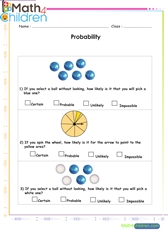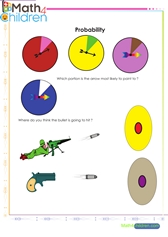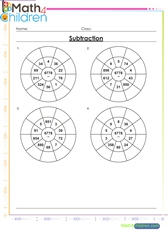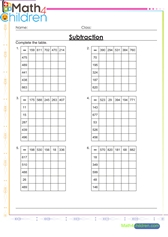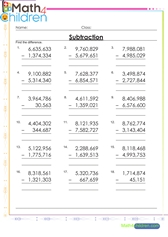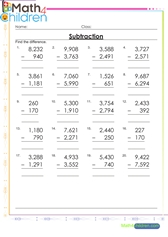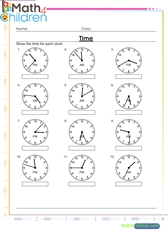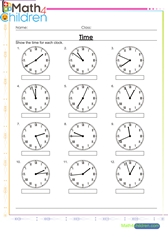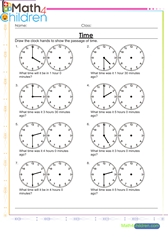Class 4 math worksheets free | Class 4 Maths Worksheet
Class 4 math worksheets free | Class 4 Math Tests | Mathematics plays a crucial role in the academic development of elementary students, and Class 4 is a critical stage where students build upon their foundational math skills. To enhance their mathematical abilities, it is essential to provide students with engaging and interactive learning materials. One effective tool in achieving this goal is the use of class 4 maths worksheets. These worksheets offer structured exercises that reinforce key concepts and promote critical thinking, problem-solving, and logical reasoning.
Addition of 3 four digit numbers
Addition of 3 four digit numbers printable math worksheet
Equations with defined variable
Equations with defined variable printable math worksheet
Comparing decimals up to thousands
Comparing decimals up to thousands printable math worksheet
Subtraction decimals circle drill
Subtraction decimals circle drill printable math worksheet
Divide numbers ending in zero by ten
Divide numbers ending in zero by ten printable math worksheet
Long division of 1 2 digit numbers
Long division of 1 2 digit numbers printable math worksheet
Multiply fractions by whole numbers
Multiply fractions by whole numbers printable math worksheet
Perimeter and area of complex shapes
Perimeter and area of complex shapes printable math worksheet
Perimeter and area of rectangles
Perimeter and area of rectangles printable math worksheet
Bar and linear graphs practice sheet
Bar and linear graphs practice sheet printable math worksheet
Converting scales mm cm feet yard
Converting scales mm cm feet yard printable math worksheet
Measure rectangles and calculate the area
Measure rectangles and calculate the area printable math worksheet
Mixed addition subtraction multiplication1
Mixed addition subtraction multiplication1 printable math worksheet
Mixed addition subtraction multiplication2
Mixed addition subtraction multiplication2 printable math worksheet
Multiplication matching exercise
Multiplication matching exercise printable math worksheet
Telling time roman numeral clocks
Telling time roman numeral clocks printable math worksheet
![]()
![]()
![]()
![]()
![]()
![]()
4th Grade - Free Math Worksheets, Games, Tests etc - MathFox
 Math End Of Term Test For Fourth (4th) Graders - Click here !
Math End Of Term Test For Fourth (4th) Graders - Click here !
Presented beneath are the covered topics for children who are currently in class 4. Class four and five both contain similar topics that are needed for children to learn. As for the third-grade topics, these will only serve them as a guide or blueprint as they progress on the fourth-grade level, wherein they will be faced with much more complex math problems. Don’t worry, the word “complex” will not scare you because we will be here to help you along your journey. For many students, third and fourth grades can be a game-changer. A number of new topics are introduced, and the rate of learning accelerates as the concepts being taught become more abstract. Problem-solving is primarily focused, and multi-step problems might be tricky. Below are four fundamental concepts that your child will learn in fourth grade: Multiplication & Division. Students continue to develop this concept in fourth grade when they begin to solve two and three-digit multiplication and division problems. At this point in the learning process, representation is critical. Challenge your kid to solve simple arithmetic problems using the Area Model, a model in which the length and width of a rectangle indicate the factors of the numbers to be multiplied or divided. Fractions. Students will continue learning and understanding unit fractions, as well as finding their equivalence, order, and comparison. Students will identify fractions that are equal to, less than, and greater than one. Encourage your children to comprehend unit fractions, which are fractions with a numerator of one, and introduce the idea of a fractions bar, which allows you to model the fractions you are working with. Measurements & Data. Students start to gather data and create various graphs to show it. Students learn about area and perimeter, as well as the relationship between multiplication and division and how it is connected to area. Encourage your child to read and analyze graphs in newspapers or on the web, as well as to calculate the area and perimeter of various objects in their home or outside their locality. Geometry. Fourth graders continue to master the different 2D-polygon categories and terminologies. They will be finding the numbers of sides and angles more easily and learn how to define these polygons. You can help your children to relate fractions to geometry. Take this as an example: cut a polygon into 4 equal parts and describe each part’s area as 1/4. Or you can also help them draw different polygons and categorize them one by one. Children are influenced by their parents' attitudes on math. When adults are worried about math or say things like "some individuals are just not good at mathematics," children will notice it. Girls, in particular, pick up on female elders' attitudes. Rather than declaring, "I'm not good at mathematics," say, "Let me strive to figure it out." Concentrate on problem-solving. Your words and attitude have an impact!
Maths worksheet of class 4
A math worksheet for class 4 is a useful tool for students to practice and review their math skills. It typically consists of a series of problems or exercises, along with space for students to show their work and write their answers. These worksheets can be used as a supplement to regular classroom instruction, or as independent practice at home.
One important aspect of a math worksheet for class 4 is that it should be well-aligned with the curriculum being taught in the classroom. This means that the worksheet should cover the same math concepts and skills that the students are learning in their lessons. For example, a math worksheet for class 4 might include problems on addition and subtraction, place value, measurement, and geometry.
In addition to covering the necessary math concepts, a math worksheet for class 4 should also be challenging, but not too difficult. It should be designed to help students build their skills and understanding, while also providing a sense of accomplishment when they complete it. This can be achieved by including a mix of easy, medium, and hard problems, as well as providing hints or worked examples for students who may need extra help.
Another important feature of a math worksheet for class 4 is that it should be engaging and interesting for students. This can be achieved through the use of fun and colorful graphics, as well as by including word problems or real-life scenarios that relate math concepts to everyday situations. For example, a math worksheet might ask students to calculate the cost of groceries at the supermarket, or to figure out how much paint is needed to cover the walls of a room.
To use a math worksheet effectively, it is important for students to have a good understanding of the math concepts and skills being covered. This can be achieved through regular classroom instruction and practice, as well as by seeking help from a teacher or tutor if needed. It is also important for students to take their time and show their work when completing a math worksheet, as this helps to reinforce their understanding and build good problem-solving skills.
In addition to being used as a supplement to regular classroom instruction, math worksheets can also be used as a form of assessment. Teachers can use worksheets to assess students' understanding of math concepts and skills, and to identify areas where they may need additional support. This can be done through the use of traditional grading methods, such as assigning points for correct answers, or by using more informal methods such as observation and feedback.
Overall, a math worksheet for class 4 is a useful tool for helping students practice and review their math skills. By covering the necessary math concepts, providing a mix of easy and challenging problems, and using engaging and interesting graphics and scenarios, a well-designed math worksheet can help students build their understanding and confidence in math. class 4 mathematics worksheet | worksheet of class 4th maths | class 4th maths test |
Class 4 Maths Worksheet: Enhancing Mathematical Skills in Elementary Students
2. The Importance of Mathematics in Class 4
In Class 4, students transition from basic arithmetic to more advanced mathematical concepts. It is a pivotal stage where they begin to comprehend mathematical operations and apply them to real-life situations. Developing a strong foundation in Class 4 mathematics is crucial as it sets the stage for future mathematical understanding. Moreover, math skills acquired during this stage serve as building blocks for higher-level math in subsequent grades.
3. Key Concepts in Class 4 Maths
Class 4 Maths covers a wide range of topics, including addition and subtraction, multiplication and division, fractions and decimals, geometry and measurement, and data handling. Let's explore each of these concepts in detail:
Addition and Subtraction
In Class 4, students expand their knowledge of addition and subtraction by solving multi-digit problems. They learn strategies such as regrouping and mental math techniques to solve complex calculations accurately.
Multiplication and Division
Class 4 introduces students to the concept of multiplication and division. They learn multiplication tables, develop mental math skills, and understand the relationship between multiplication and division.
Fractions and Decimals
Students delve into the world of fractions and decimals in Class 4. They learn to identify, compare, and perform operations with fractions and decimals, laying the foundation for advanced mathematical concepts.
Geometry and Measurement
Geometry and measurement enable students to explore shapes, angles, lines, and measurements. They learn to calculate perimeter, area, and understand the properties of various geometric figures.
Data Handling
In Class 4, students develop skills in collecting, organizing, and interpreting data. They learn to create bar graphs, pictographs, and tables, which help them analyze and draw conclusions from real-life data sets.
4. Designing Effective Class 4 Maths Worksheets
Designing effective class 4 maths worksheets requires careful consideration of the learning objectives, curriculum guidelines, and students' proficiency levels. Here are some key elements to consider when creating engaging worksheets:
- Clear instructions: Provide step-by-step instructions that guide students through the problem-solving process.
- Gradual difficulty progression: Start with simple exercises and gradually increase the complexity to challenge students' skills.
- Variety of question types: Include multiple-choice, fill-in-the-blanks, word problems, and visual representations to cater to different learning styles.
- Real-life applications: Incorporate real-life scenarios to demonstrate the practical relevance of mathematical concepts.
- Interactive elements: Include interactive elements like puzzles, games, or hands-on activities to make learning enjoyable.
5. Worksheet Example: Addition and Subtraction
Worksheet Title: Exploring Addition and Subtraction
-
Add the following numbers: a) 356 + 142 b) 789 + 293 c) 421 + 579
-
Subtract the following numbers: a) 893 - 412 b) 654 - 321 c) 829 - 341
6. Worksheet Example: Multiplication and Division
Worksheet Title: Mastering Multiplication and Division
-
Solve the following multiplication problems: a) 5 x 8 b) 7 x 6 c) 9 x 3
-
Solve the following division problems: a) 36 ÷ 6 b) 48 ÷ 8 c) 63 ÷ 9
7. Worksheet Example: Fractions and Decimals
Worksheet Title: Exploring Fractions and Decimals
-
Compare the following fractions: a) 3/4 ___ 4/5 b) 2/3 ___ 5/6 c) 1/2 ___ 3/8
-
Convert the following fractions to decimals: a) 1/4 b) 3/5 c) 2/7
8. Worksheet Example: Geometry and Measurement
Worksheet Title: Discovering Geometry and Measurement
-
Calculate the perimeter of the following shapes: a) Rectangle: length = 8 cm, width = 5 cm b) Square: side length = 6 cm c) Triangle: side lengths = 3 cm, 4 cm, 5 cm
-
Calculate the area of the following shapes: a) Rectangle: length = 12 cm, width = 7 cm b) Circle: radius = 5 cm c) Triangle: base = 6 cm, height = 9 cm
9. Worksheet Example: Data Handling
Worksheet Title: Exploring Data Handling
-
Interpret the given bar graph and answer the questions: [Include a bar graph here]
a) Which month had the highest sales? b) How many units were sold in May? c) Compare the sales of Product A and Product B in April.
-
Create a pictograph representing the number of students in each grade: [Include a pictograph template here]
10. Benefits of Using Worksheets in Class 4 Maths
- Reinforce key concepts: Worksheets provide ample practice opportunities for students to reinforce their understanding of class 4 math concepts.
- Enhance problem-solving skills: Worksheets encourage students to apply mathematical concepts to solve problems, fostering critical thinking and analytical skills.
- Track progress: Worksheets allow teachers to assess students' progress and identify areas that require additional support.
- Individualized learning: Worksheets can be tailored to cater to students' individual needs, providing targeted practice and addressing specific areas of difficulty.
11. Conclusion
Class 4 maths worksheets are valuable resources that help students develop and strengthen their mathematical skills. By providing structured exercises, these worksheets enhance problem-solving abilities, critical thinking, and logical reasoning. Incorporating worksheets into class 4 mathematics education promotes active engagement and deepens students' understanding of fundamental mathematical concepts.
FAQs (Frequently Asked Questions)
Q1: How can I make learning math more enjoyable for my class 4 students? A: To make learning math enjoyable, incorporate hands-on activities, games, and real-life examples into your teaching. Additionally, use interactive math resources and encourage students to collaborate and discuss problem-solving strategies.
Q2: Are there any online resources for printable class 4 maths worksheets? A: Yes, several websites offer free and printable class 4 maths worksheets. You can explore educational platforms, teaching blogs, or educational resource-sharing websites for a wide range of worksheets.
Q3: What skills can class 4 students develop through math worksheets? A: Math worksheets help class 4 students develop critical thinking, problem-solving, logical reasoning, and numerical fluency. They also enhance skills such as data interpretation, pattern recognition, and spatial reasoning.
Q4: How can parents support their children in practicing math at home? A: Parents can support their children by creating a conducive learning environment, encouraging regular practice, and providing access to math-related resources such as worksheets, educational games, and online tutorials. It is also beneficial to engage in math-related discussions and real-life applications.
Q5: Are there any alternative methods for teaching math besides worksheets? A: Yes, there are alternative methods for teaching math. Teachers can incorporate hands-on activities, manipulatives, educational games, group work, and technology-based resources to make math learning more interactive and engaging.
-
 Math End Of Term Test For Fourth (4th) Graders Or Math Placement test for 5th Grade
Math End Of Term Test For Fourth (4th) Graders Or Math Placement test for 5th Grade Algebra Quizzes
Algebra Quizzes- Algebra Addition- Finding the Value of X - Quiz
- Algebra Word Problem Quiz
- Mixed algebra operations quiz
- Subtractions finding the value of X quiz
 Fractions Quizzes
Fractions Quizzes- Adding Fractions Quiz
- Fractions in Simplest Terms Quiz
- Fractions greater or less than quiz
- Converting Fractions to Mixed numerals
- Fractions Subtractions Quiz
 Geometry Quizzes
Geometry Quizzes

